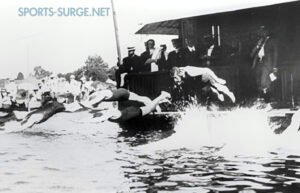The Olympic Games, a celebration of athleticism, unity, and sportsmanship, have seen some of the most iconic moments in sports history. From Usain Bolt’s record-breaking sprints to Simone Biles’ gravity-defying gymnastics, the Olympics are synonymous with awe-inspiring performances. However, beyond the mainstream events that dominate the headlines, the Olympics have also played host to some truly weird and quirky sports. These unusual events add a unique charm to the Games, showcasing the diverse ways humans test their physical and mental limits.
In this blog, we explore the fascinating world of weird Olympic sports, past and present, shedding light on their origins, rules, and why they stood out in the world’s biggest sporting event.
Table of Contents
ToggleLive Pigeon Shooting (1900)
Imagine an Olympic event where competitors aim at live pigeons. In the 1900 Paris Olympics, this peculiar event made its first and only appearance. The goal was simple: shoot as many pigeons as possible within the allotted time. While it may sound shocking today, this event was a reflection of a time when hunting was a celebrated skill.
The winner, Belgian shooter Leon de Lunden, bagged 21 birds to take home the gold medal. Over 300 pigeons were killed during the competition, leading to a significant outcry. The event’s ethical implications ensured it was never included again. Instead, modern shooting events replaced live targets with clay ones.
Solo Synchronized Swimming (1984-1992)

Synchronized swimming, typically performed in duets or teams, took a bizarre turn with the introduction of solo synchronized swimming. The irony of synchronizing with oneself baffled audiences and critics alike. Athletes performed choreographed routines in the water to music, demonstrating grace and precision.
While it required immense skill, the concept didn’t quite resonate with viewers, leading to its removal after the 1992 Olympics. Today, synchronized swimming—now called artistic swimming—is exclusively a team or duet event.
Tug-of-War (1900-1920)
A classic playground game turned Olympic sport, tug-of-war featured in the Olympics from 1900 to 1920. Teams of eight competed to pull their opponents across a designated line, showcasing raw strength and teamwork.
This event was part of the athletics category and saw intense rivalries, particularly between British and Scandinavian teams. The sport’s simplicity and accessibility made it a crowd favorite. However, it was eventually discontinued as the Olympics moved toward more specialized sports.
Plunge for Distance (1904)
In the 1904 St. Louis Olympics, athletes competed in a peculiar swimming event called “plunge for distance.” Participants dove into the water and remained motionless, allowing their momentum to carry them forward. The winner was determined by who traveled the farthest without moving their limbs.
The event reflected a time when swimming competitions explored unique disciplines. However, its lack of dynamic action and limited appeal led to its swift disappearance from the Olympic program.
Skijoring (Demonstration Sport, 1928)

Skijoring, a thrilling mix of skiing and horse riding, made its Olympic debut as a demonstration sport in the 1928 Winter Games in St. Moritz. Competitors on skis were pulled by horses, racing across snow-covered tracks at breakneck speeds.
While undeniably exciting, the sport’s reliance on animals and its niche appeal prevented it from becoming an official Olympic event. Today, skijoring continues as a recreational activity in snowy regions, often replacing horses with motorized vehicles.
Art Competitions (1912-1948)
Believe it or not, the Olympics once celebrated artistic talents alongside athletic prowess. From 1912 to 1948, the Games included competitions in literature, painting, music, sculpture, and architecture. Entries had to be inspired by sports, and medals were awarded to the best works.
While the inclusion of arts was a nod to the ancient Greek tradition of blending physical and intellectual pursuits, it faced criticism for subjective judging and lack of professional entries. Eventually, art competitions were replaced by cultural exhibitions held alongside the Games.
Rope Climbing (1896, 1904, 1906, 1924)
Rope climbing, a staple of school gymnasiums, was once an Olympic event. Competitors had to climb a vertical rope as quickly as possible, with medals awarded for speed and style. The event was featured in various early Olympics, with the rope length and judging criteria varying by year.
As gymnastics evolved into a more comprehensive discipline, rope climbing faded from the spotlight. Today, it’s remembered as a testament to the diverse challenges embraced by early Olympians.
Equestrian Vaulting (1920)
Equestrian vaulting combines gymnastics and horse riding, with athletes performing acrobatic routines on a moving horse. This unique sport was included in the 1920 Olympics but failed to gain traction.
While it’s no longer an Olympic event, equestrian vaulting continues to thrive as a competitive discipline, showcasing the bond between rider and horse and the extraordinary balance and agility of the athletes.
Underwater Swimming (1900)

The 1900 Paris Olympics featured underwater swimming, where competitors were judged on how far they could swim and how long they could stay submerged. Points were awarded for distance and duration, making it a true test of breath control and endurance.
While intriguing, the event’s limited spectator visibility and inherent risks led to its exclusion from future Games. Modern swimming events now focus on speed and technique in visible settings.
Croquet (1900)
Croquet, a leisurely lawn game, briefly graced the Olympics in 1900. The event featured various formats, including singles and doubles, with participants competing to navigate a course of hoops using mallets and balls.
Despite its historical roots and strategic complexity, croquet’s slow pace and lack of international participation limited its appeal. It remains a recreational activity enjoyed by enthusiasts worldwide.
Why Do Weird Sports Matter?
While many of these events seem bizarre today, they highlight the evolution of the Olympics and the diversity of human interests. Weird sports often reflect the cultural and historical contexts of their time, showcasing skills and traditions that were once celebrated.
Moreover, these unusual events remind us that the Olympics are about more than just competition; they’re a platform for creativity, experimentation, and inclusivity. From showcasing artistic talents to testing unconventional physical feats, the Games have always embraced the unexpected.
Could Weird Sports Return?
In recent years, the International Olympic Committee (IOC) has shown a willingness to experiment with new sports to attract younger audiences. Skateboarding, surfing, and sport climbing made their debuts at the Tokyo 2020 Olympics, signaling a shift toward modern, youth-oriented events.
This openness to innovation raises the question: Could some of these weird sports make a comeback? While events like live pigeon shooting and underwater swimming are unlikely to return, others like tug-of-war or even equestrian vaulting could find a place in the modern Games with updated formats.
Conclusion
The Weird Olympic Sports remind us that the Games are more than just a showcase of physical prowess; they’re a celebration of human creativity and diversity. From the thrill of skijoring to the artistry of solo synchronized swimming, these unusual events have left an indelible mark on Olympic history.
As the Olympics continue to evolve, who knows what new or revived sports might surprise us in the future? Whether weird, wonderful, or both, these events ensure the Games remain a captivating and ever-changing spectacle for audiences around the world.
FAQs about Weird Olympic Sports
What are some of the strangest sports ever included in the Olympic Games?
Throughout Olympic history, several unconventional sports have been featured, including:
- Live Pigeon Shooting (1900): Participants aimed to shoot as many live pigeons as possible, resulting in the death of over 300 birds. This event was short-lived due to ethical concerns.
- Solo Synchronized Swimming (1984-1992): Athletes performed synchronized routines alone, which led to confusion and was eventually discontinued.
- Tug-of-War (1900-1920): A classic game where teams competed to pull the opposing team across a line. It was part of the athletics category but was later removed.
- Plunge for Distance (1904): Competitors dived into a pool and glided underwater without propulsion, with the winner covering the longest distance.
- Skijoring (Demonstration Sport, 1928): Skiers were pulled by horses over snow-covered tracks, showcasing a blend of skiing and equestrian skills.
Why were these unusual sports removed from the Olympic program?
Many of these sports were removed due to factors such as:
- Lack of International Appeal: Sports like croquet and tug-of-war did not have widespread global participation.
- Ethical Concerns: Events like live pigeon shooting faced backlash over animal cruelty.
- Spectator Engagement: Some events lacked excitement or visibility, such as underwater swimming, leading to decreased audience interest.
- Standardization Issues: Inconsistent rules and judging criteria made some sports difficult to officiate fairly.
Are there any new or unconventional sports included in recent Olympics?
Yes, the International Olympic Committee has introduced several new sports to appeal to younger audiences and reflect contemporary interests:
- Skateboarding: Debuted in Tokyo 2020, featuring street and park disciplines.
- Sport Climbing: Introduced in Tokyo 2020, testing athletes in speed, bouldering, and lead climbing.
- Surfing: Also debuted in Tokyo 2020, with competitions held on natural ocean waves.
- Breaking (Breakdancing): Set to debut in Paris 2024, bringing urban dance culture to the Olympic stage.
What criteria does the IOC use to include or exclude sports from the Olympics?
The International Olympic Committee evaluates sports based on several criteria:
- Youth Appeal: Attracting younger audiences to keep the Olympics relevant.
- Global Popularity: Widespread participation across different countries and continents.
- Gender Equality: Ensuring equal opportunities for male and female athletes.
- Infrastructure and Cost: Feasibility of hosting the sport without excessive costs or the need for specialized facilities.
- Historical Significance: The sport’s tradition and history within the Olympic movement.
Could any of these discontinued sports make a comeback in future Olympics?
While it’s possible for discontinued sports to return, it depends on factors like renewed global interest, updated rules, and alignment with the IOC’s current objectives. For instance, sports like baseball and softball were reintroduced in Tokyo 2020 after being absent since 2008. However, events with ethical concerns or limited appeal, such as live pigeon shooting, are unlikely to return.
What are some of the most recent additions to the Olympic program as of 2024?
As of 2024, the latest additions to the Olympic program include:
- Breaking (Breakdancing): Making its debut in Paris 2024, featuring B-boys and B-girls competing in dance battles.
- Sport Climbing: Continues after its introduction in Tokyo 2020, with events in speed, bouldering, and lead climbing.
- Surfing: Maintained in Paris 2024, with competitions expected to be held in natural ocean settings.
- Skateboarding: Also continuing from Tokyo 2020, featuring both street and park disciplines.

